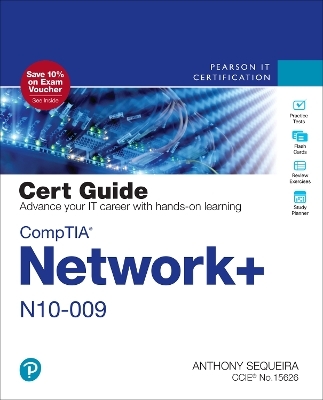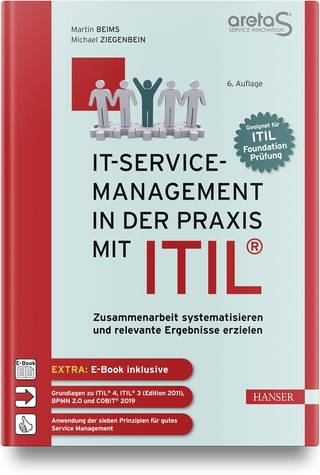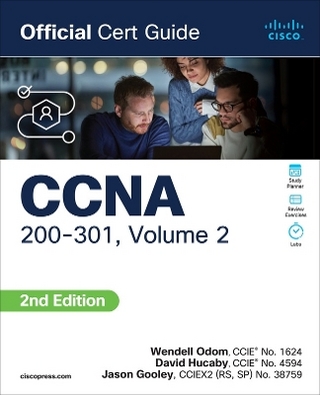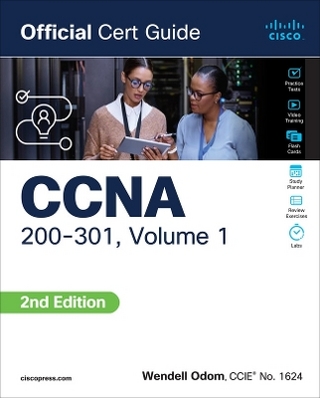
CompTIA Network+ N10-009 Cert Guide
Pearson IT Certification (Verlag)
978-0-13-536788-9 (ISBN)
CompTIA Network+ N10-009 Cert Guide from Pearson IT Certification helps you prepare to succeed on the CompTIA Network+ N10-009 exam by directly addressing the exam’s objectives as stated by CompTIA. Leading instructor Anthony Sequeira shares preparation hints and test-taking tips, helping you identify areas of weakness and improve both your conceptual knowledge and hands-on skills.
This complete study package includes
Complete coverage of the exam objectives and a test-preparation routine designed to help you pass the exams
Do I Know This Already? quizzes, which enable you to decide how much time you need to spend on each section
Chapter-ending Key Topic tables, which help you drill on key concepts you must know thoroughly
The powerful Pearson Test Prep Practice Test software, complete with hundreds of well-reviewed, exam-realistic questions, customization options, and detailed performance reports
An online, interactive Flash Cards application to help you drill on key terms by chapter
A final preparation chapter, which guides you through tools and resources to help you craft your review and test-taking strategies
Study plan suggestions and templates to help you organize and optimize your study time
Well regarded for its level of detail, study plans, assessment features, and challenging review questions and exercises, this study guide helps you master the concepts and techniques that ensure your exam success.
This study guide helps you master all the topics on the CompTIA Network+ N10-009 exam, deepening your knowledge of
Networking Concepts: Open systems interconnection reference model; networking appliances, applications and functions; cloud concepts and connectivity options; networking ports, protocols, services, traffic types; transmission media and transceivers; network topologies, architectures, and types; IPv4 network addressing; modern network environments
Networking Implementation: Routing technologies, switching technologies and features, wireless devices, physical installations
Network Operations: Organizational processes, network monitoring technologies, disaster recovery (DR) concepts, IPv4 and IPv6 network services, network access and management methods
Network Security: Basic network security concepts, types of attacks and their impact on the network, network security features, defense techniques and solutions
Network Troubleshooting: Troubleshooting methodology, common cabling and physical interface issues, troubleshooting common issues with network services, troubleshooting common performance issues, solving networking issues
Anthony Sequeira (CCIE No. 15626) began his IT career in 1994 with IBM in Tampa, Florida. He quickly formed his own computer consultancy, Computer Solutions, and then discovered his true passion: teaching and writing about networking technologies. Anthony lectured to massive audiences around the world while working for Mastering Computers. Anthony has never been happier in his career than he is now, as a senior technical instructor for ACI Learning. ACI is a leader in audit, cybersecurity, and IT pro training in self-paced and instructor-led formats.
Introduction xxxv
Part I: Networking Concepts
Chapter 1 The OSI Model and Encapsulation 3
Foundation Topics 4
The Purpose of Reference Models 4
The OSI Model 6
Layer 1: The Physical Layer 7
Layer 2: The Data Link Layer 11
Media Access Control 12
Logical Link Control 13
Layer 3: The Network Layer 14
Layer 4: The Transport Layer 17
Layer 5: The Session Layer 19
Layer 6: The Presentation Layer 20
Layer 7: The Application Layer 21
The TCP/IP Stack 22
Layers of the TCP/IP Stack 22
Common Application Protocols in the TCP/IP Stack 26
Real-World Case Study 27
Summary 28
Exam Preparation Tasks 28
Chapter 2 Networking Appliances, Applications, and Functions 35
Foundation Topics 36
Physical and Virtual Appliances 36
Routers 36
Switches 36
Firewalls 45
Intrusion Detection System (IDS)/Intrusion Prevention System (IPS) 46
IDS Versus IPS 46
IDS and IPS Device Categories 47
Signature-Based Detection 48
Policy-Based Detection 48
Anomaly-Based Detection 48
Load Balancer 49
Proxy Servers 49
Network-attached Storage (NAS) 51
Storage Area Networks (SANs) 51
Access Points (APs) 52
Controllers 53
Networking Device Summary 53
Applications and Functions 54
Content Delivery Network (CDN) 54
Virtual Private Network (VPN) 55
Quality of Service (QoS) 55
Time to Live (TTL) 57
Real-World Case Study 57
Summary 58
Exam Preparation Tasks 58
Chapter 3 Cloud Concepts 65
Foundation Topics 66
Network Functions Virtualization (NFV) 66
Cloud Networking Components 67
Virtual Private Cloud (VPC) 67
Network Security Groups 68
Network Security Lists 69
Cloud Gateways 69
Deployment Models 71
Service Models 72
Key Cloud Concepts 73
Cloud Connectivity Options 73
Multitenancy 74
Elasticity 74
Scalability 75
Real-World Case Study 75
Summary 75
Exam Preparation Tasks 76
Chapter 4 Networking Ports, Protocols, Services, and Traffic Types 81
Foundation Topics 82
Ports and Protocols 82
FTP (File Transfer Protocol) 82
SFTP 82
SSH 82
Telnet 82
SMTP 83
DNS (Domain Name System) 83
DHCP (Dynamic Host Configuration Protocol) 83
TFTP 83
HTTP 83
NTP 83
SNMP 84
LDAP 84
HTTPS 84
SMB 84
Syslog 84
SMTPS 85
LDAPS 85
Structured Query Language (SQL) Server 85
RDP 85
SIP 85
Protocol/Port Summary 85
Internet Protocol (IP) Types 87
Internet Control Message Protocol (ICMP) 87
Transmission Control Protocol (TCP) 88
User Datagram Protocol (UDP) 88
Generic Routing Encapsulation (GRE) 88
Internet Protocol Security (IPsec) 89
Internet Protocol (IP) Types Summary 89
Traffic Types 90
Unicast 90
Broadcast 91
Multicast 91
Anycast 92
Traffic Types Summary 94
Summary 95
Exam Preparation Tasks 95
Chapter 5 Transmission Media and Transceivers 101
Foundation Topics 102
Wireless 102
Transmission Methods 105
WLAN Standards (802.11) 106
802.11a 106
802.11b 106
802.11g 106
802.11n (Wi-Fi 4) 106
802.11ac (Wi-Fi 5) 107
802.11ax (Wi-Fi 6) 107
802.11 Standards Summary 108
Cellular 108
Satellite 109
Copper and Fiber Media and Connectors 111
Coaxial Cable 111
Twisted-Pair Cable 113
Shielded Twisted Pair 113
Unshielded Twisted Pair 114
Twisted-Pair Cable Connectors 116
Plenum Versus Non-plenum Cable 117
Fiber-Optic Cable 117
Multimode Fiber 118
Single-Mode Fiber 120
Fiber-Optic Cable Connectors 120
Fiber Connector Polishing Styles 121
Ethernet and Fiber Standards (802.3) 122
Distance and Speed Limitations 124
Transceivers 126
Multiplexing in Fiber-Optic Networks 127
Media Converters 127
Real-World Case Study 128
Summary 128
Exam Preparation Tasks 128
Chapter 6 Network Topologies, Architectures, and Types 135
Foundation Topics 136
Defining a Network 136
The Purpose of Networks 136
Network Types and Characteristics 137
LAN 137
WAN 138
WLAN 138
SAN 139
Other Categories of Networks 139
CAN 139
MAN 139
PAN 139
Networks Defined Based on Resource Location 140
Client/Server Networks 140
Peer-to-Peer Networks 141
Cloud Networking 143
Networks Defined by Topology 143
Physical Versus Logical Topology 143
Point-to-Point Topology 145
Star Topology 145
Hub-and-Spoke Topology 146
Full-Mesh Topology 147
Partial-Mesh Topology 148
The Three-Tier Hierarchical Model 150
The Access/Edge Layer 150
The Distribution/Aggregation Layer 151
The Core Layer 152
Spine and Leaf 153
Traffic Flows 155
Real-World Case Study 155
Summary 155
Exam Preparation Tasks 156
Chapter 7 IPv4 Addressing 163
Foundation Topics 164
Binary Numbering 164
Principles of Binary Numbering 164
Converting a Binary Number to a Decimal Number 165
Converting a Decimal Number to a Binary Number 165
Binary Numbering Practice 167
Binary Conversion Exercise 1 167
Binary Conversion Exercise 1: Solution 168
Binary Conversion Exercise 2 168
Binary Conversion Exercise 2: Solution 168
Binary Conversion Exercise 3 168
Binary Conversion Exercise 3: Solution 169
Binary Conversion Exercise 4 169
Binary Conversion Exercise 4: Solution 170
IPv4 Addressing 170
IPv4 Address Structure 171
Classes of Addresses 173
Assigning IPv4 Addresses 175
IP Addressing Components 175
Static Configuration 176
Dynamic Configuration 180
Automatic Private IP Addressing 180
Subnetting 181
Purpose of Subnetting 182
Subnet Mask Notation 182
Subnet Notation: Practice Exercise 1 184
Subnet Notation: Practice Exercise 1 Solution 184
Subnet Notation: Practice Exercise 2 184
Subnet Notation: Practice Exercise 2 Solution 185
Extending a Classful Mask 185
Borrowed Bits 185
Calculating the Number of Created Subnets 185
Calculating the Number of Available Hosts 186
Basic Subnetting Practice: Exercise 1 187
Basic Subnetting Practice: Exercise 1 Solution 187
Basic Subnetting Practice: Exercise 2 188
Basic Subnetting Practice: Exercise 2 Solution 188
Calculating New IP Address Ranges 189
Advanced Subnetting Practice: Exercise 1 192
Advanced Subnetting Practice: Exercise 1 Solution 192
Advanced Subnetting Practice: Exercise 2 193
Advanced Subnetting Practice: Exercise 2 Solution 193
Additional Practice 195
Classless Inter-domain Routing 196
Real-World Case Study 197
Summary 198
Chapter 8 Evolving Use Cases 203
Foundation Topics 205
SDN and SD-WAN 205
Software-Defined Networking (SDN) 205
Software-Defined Wide Area Network (SD-WAN) 206
Virtual Extensible Local Area Network (VXLAN) 208
Zero Trust Architecture (ZTA) 209
SASE and SSE 211
Infrastructure as Code (IaC) 212
IP Version 6 215
Need for IPv6 216
IPv6 Address Structure 217
IPv6 Address Types 217
IPv6 Data Flows 218
Unicast 219
Multicast 219
Anycast 220
Real-World Case Study 221
Summary 222
Exam Preparation Tasks 223
Part II: Network Implementation
Chapter 9 Routing Technologies 229
Foundation Topics 230
Routing 230
Sources of Routing Information 233
Directly Connected Routes 233
Static Routes 234
Dynamic Routing Protocols 235
Routing Protocol Characteristics 237
Believability of a Route 237
Metrics 238
Interior Versus Exterior Gateway Protocols 238
Route Advertisement Method 238
Distance Vector 239
Link State 242
Routing Protocol Examples 242
Address Translation 244
NAT 244
PAT 246
First Hop Redundancy Protocol (FHRP) 248
Real-World Case Study 250
Summary 250
Exam Preparation Tasks 251
Chapter 10 Ethernet Switching Technologies 257
Foundation Topics 258
Principles of Ethernet 258
Carrier-Sense Multiple Access with Collision Detection 258
Distance and Speed Limitations 262
Ethernet Switch Features 263
Virtual LANs 263
Switch Configuration for an Access Port 266
Trunks 267
Switch Configuration for a Trunk Port 268
Spanning Tree Protocol 269
Corruption of a Switch’s MAC Address Table 269
Broadcast Storms 270
STP Operation 271
Modern Enhancements to STP 274
Link Aggregation 275
LACP Configuration 276
Power over Ethernet 277
Other Switch Features 278
Real-World Case Study 279
Summary 279
Exam Preparation Tasks 280
Chapter 11 Configure Wireless Devices and Technologies 285
Foundation Topics 286
Introducing Wireless LANs 286
WLAN Concepts and Components 286
Wireless Routers 286
Wireless Access Point 287
Guest Networks 289
Antennas 289
Channel and Frequency Options 292
Deploying Wireless LANs 293
Types of WLANs 293
IBSS 293
BSS 294
ESS 295
Mesh Topology 295
Sources of Interference 296
Wireless AP Placement 297
Securing Wireless LANs 299
Security Issues 299
Approaches to WLAN Security 300
Security Standards 303
WPA2 303
WPA3 303
Additional Wireless Options 303
Real-World Case Study 304
Summary 305
Exam Preparation Tasks 305
Chapter 12 Physical Installations 311
Foundation Topics 312
Important Installation Implications 312
Locations 313
Power 315
Environmental Factors 317
Real-World Case Study 318
Summary 320
Exam Preparation Tasks 320
Part III: Network Operations
Chapter 13 Organizational Processes and Procedures 325
Foundation Topics 326
Documentation 326
Processes and Procedures 329
Life-cycle Management 329
Change Management 332
Configuration Management 333
Real-World Case Study 334
Summary 335
Exam Preparation Tasks 336
Chapter 14 Network Monitoring 341
Foundation Topics 342
Network Monitoring Methods 342
SNMP 342
Performance Metrics/Sensors 345
Port Mirroring 348
Port Mirroring Configuration 350
Logging 350
Syslog 351
Other Logs 353
NetFlow 354
API Integration 354
Monitoring Solutions 355
Real-World Case Study 357
Summary 357
Exam Preparation Tasks 358
Chapter 15 Disaster Recovery 363
Foundation Topics 364
High Availability 364
High-Availability Measurement 364
DR Metrics 364
Fault-Tolerant Network Design 365
Hardware Redundancy 367
Design Considerations for High-Availability Networks 368
High-Availability Best Practices 369
Content Caching 370
Load Balancing 370
Hardware Redundancy 370
Testing 372
Real-World Case Study: Network Design 372
Case Study Scenario 373
Suggested Solution 375
IP Addressing 375
Layer 1 Media 376
Layer 2 Devices 376
Layer 3 Devices 377
Wireless Design 378
Environmental Factors 379
Cost Savings Versus Performance 379
Topology 379
Summary 380
Exam Preparation Tasks 380
Chapter 16 IPv4 and IPv6 Network Services 385
Foundation Topics 386
Dynamic Addressing 386
DHCP 386
SLAAC 389
Name Resolution 390
DNS 391
Hosts File 396
Time Protocols 397
NTP 397
PTP 398
NTS 399
Real-World Case Study 399
Summary 400
Exam Preparation Tasks 400
Chapter 17 Network Access and Management Methods 405
Foundation Topics 406
Virtual Private Networks (VPNs) 406
IPsec 408
IKE 408
Authentication Header and Encapsulating Security Payload 410
The Five Steps in Setting Up and Tearing Down an IPsec Site-to-Site VPN Using IKEv1 412
IKEv2 413
Other VPN Technologies 413
Other Network Access Technologies 414
Authentication and Authorization Considerations 417
In-Band vs. Out-of-Band Management 418
Real-World Case Study 418
Summary 419
Exam Preparation Tasks 419
Part IV: Network Security
Chapter 18 Network Security Concepts 425
Foundation Topics 426
Core Security Concepts 426
Confidentiality, Integrity, and Availability (CIA) 426
Confidentiality 426
Symmetric Encryption 427
Asymmetric Encryption 428
Integrity 430
Availability 431
Threats, Vulnerabilities, Risks, and Exploits 431
Threats 432
Vulnerabilities 432
Risks 433
Exploits 433
Least Privilege 433
Role-Based Access Control 434
Defense in Depth 434
Screened Subnet 435
Separation of Duties 435
Network Access Control 435
Honeypot 435
Network Segmentation Enforcement 436
IoT and IIoT 436
SCADA, ICS, and OT 437
Guest Networks 437
BYOD 437
Authentication Methods 438
Multifactor 438
TACACS+ 439
Single Sign-On 439
RADIUS 439
LDAP 440
Kerberos 440
SAML 441
Time-based Authentication 441
Local Authentication 441
Risk Management and SIEM 441
Risk Management 441
Security Risk Assessments 442
Threat Assessment 442
Vulnerability Assessment 442
Penetration Testing 442
Posture Assessment 442
Business Risk Assessment 442
Process Assessment 443
Vendor Assessment 443
Security Information and Event Management (SIEM) 443
Physical Security 444
Detection Methods 444
Prevention Methods 445
Audits and Regulatory Compliance 447
Real-World Case Study 448
Summary 449
Exam Preparation Tasks 449
Chapter 19 Types of Network Attacks 457
Foundation Topics 458
Technology-Based Attacks 458
Denial-of-Service (DoS) 458
Distributed Denial-of-Service (DDoS) 459
On-Path Attack 459
DNS Poisoning 460
VLAN Hopping 460
ARP Poisoning 460
ARP Spoofing 461
Rogue DHCP 461
Rogue Access Point 461
Evil Twin 461
Ransomware 461
Password Attacks 462
MAC Spoofing 462
MAC Flooding 462
IP Spoofing 463
Deauthentication 463
Malware 463
Social Engineering Attacks 464
Other Miscellaneous Attacks 465
Real-World Case Study 469
Summary 470
Exam Preparation Tasks 470
Chapter 20 Network Security Features 475
Foundation Topics 476
Device Hardening 476
Best Practices 476
Network Access Control (NAC) 480
Other Network Security Features 482
Real-World Case Study 483
Summary 483
Exam Preparation Tasks 484
Part V: Network Troubleshooting
Chapter 21 A Network Troubleshooting Methodology 489
Foundation Topics 490
Troubleshooting Basics 490
Troubleshooting Fundamentals 490
Structured Troubleshooting Methodology 492
Real-World Case Study 495
Summary 495
Exam Preparation Tasks 496
Chapter 22 Troubleshoot Common Cabling Problems 501
Foundation Topics 502
Specifications and Limitations 502
Common Cable Issues 502
Common Interface Issues 505
Common Hardware Issues 506
Common Tools 507
Real-World Case Study 511
Summary 512
Exam Preparation Tasks 512
Chapter 23 Troubleshoot Common Issues with Network Services 517
Foundation Topics 518
Considerations for General Network Troubleshooting 518
Common Network Service Issues 519
Real-World Case Study 523
Summary 524
Exam Preparation Tasks 524
Chapter 24 Troubleshoot Common Performance Issues 529
Foundation Topics 530
Network Performance Considerations 530
Wireless Performance Considerations 531
Other Wireless Considerations 533
Antennas 533
Frequencies and Channels 533
More Considerations 534
Common Wireless Issues 534
Wireless Network Troubleshooting 536
Wireless Network Troubleshooting Solution 536
Real-World Case Study 537
Summary 538
Exam Preparation Tasks 538
Chapter 25 Network Troubleshooting Tools 543
Foundation Topics 544
Software Tools 544
Protocol Analyzer/Packet Capture 544
Bandwidth Speed Tester 544
Port Scanner 544
iperf 545
NetFlow Analyzers 546
TFTP Server 546
Terminal Emulator 546
IP Scanner 546
LLDP/CDP 546
Command-Line Tools 547
ping 547
ping with IPv6 549
ipconfig 549
ifconfig 553
ip 554
nslookup 554
dig 556
traceroute 557
traceroute for IPv6 558
arp 558
netstat 560
hostname 562
route 562
telnet 567
tcpdump 567
nmap 567
Basic Networking Device Commands 567
Hardware Tools 568
Wi-Fi Analyzer 568
Tone Generator 569
Cable Tester 569
Tap 569
Visual Fault Locator 569
Real-World Case Study 570
Summary 570
Exam Preparation Tasks 570
Part VI: Final Preparation and Exam Updates
Chapter 26 Final Preparation 577
Tools for Final Preparation 577
Video Training 578
Memory Tables 578
End-of-Chapter Review Tools 579
Suggested Plan for Final Review and Study 579
Strategies for Taking the Exam 581
Summary 582
Chapter 27 CompTIA Network+ N10-009 Cert Guide Exam Updates 585
Always Get the Latest at the Book’s Product Page 585
Technical Content 586
Part VII: Appendixes
Appendix A Answers to Review Questions 587
Online Elements
Appendix B Memory Tables
Appendix C Memory Tables Answer Key
Appendix D Study Planner
Glossary of Key Terms
9780135367889 TOC 10/30/2024
| Erscheinungsdatum | 18.12.2024 |
|---|---|
| Reihe/Serie | Certification Guide |
| Verlagsort | Upper Saddle River |
| Sprache | englisch |
| Themenwelt | Mathematik / Informatik ► Informatik ► Netzwerke |
| Informatik ► Weitere Themen ► Zertifizierung | |
| ISBN-10 | 0-13-536788-3 / 0135367883 |
| ISBN-13 | 978-0-13-536788-9 / 9780135367889 |
| Zustand | Neuware |
| Informationen gemäß Produktsicherheitsverordnung (GPSR) | |
| Haben Sie eine Frage zum Produkt? |
aus dem Bereich


